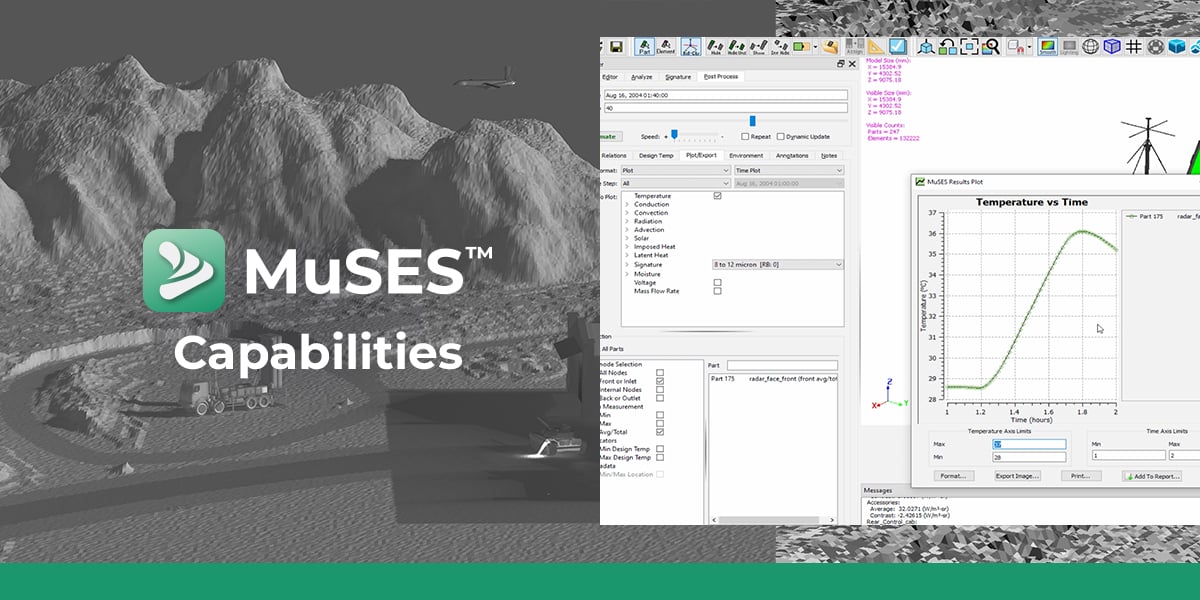
Thermal signature analysis has been a central focus of our company since 1997, when we introduced MuSES software to predict temperatures and infrared radiosity (the "brightness" of things to a thermal imager). MuSES remains the benchmark for EO signature prediction accuracy due to its first-principles physics engine and highly optimized algorithms for solving transient thermal behavior. Because the natural environment and targets or objects of interest tend to be dynamic, MuSES software has native transiency. It incorporates local weather data to predict temperatures, solve EO radiosity, and render images for training machine learning classifiers to determine the probability of detection and the likelihood of identification.
AI and automatic target recognition scientists often desire to compute POD and POI: the values of the likelihood that a target can be found (detected) or recognized (identified) in a given environment using an electro-optic sensor at some range through the atmosphere. This could be a ship in a harbor, a human in a forest, or an anti-aircraft battery under a tarp. The constraints of costly testing often limit the scientist to generate measured imagery under known or controlled conditions. Furthermore, he or she would require a massive effort to design experiments that isolate the interactions of thermal exchange and atmospheric attenuation.
We use meshed CAD geometry to provide the target's surfaces and surrounding environment to develop these infrared images. In MuSES, we assign properties to the models' parts to account for the material (for example, aluminum) and the surface condition (such as paint with measured spectral properties). Heat sources and environmental conditions are also defined so that our model takes on an accurate temperature distribution under the weather and specific day/time with diffuse, direct, and reflected solar loads.
Our engineering team can do this type of modeling, or we can train your staff to build models, run them, and generate accurate at-range renderings. Once you have established a base model, you can vary parameters and assess each change's impact – giving your AI model greater dimensionality. For example, how would a measured image change if the humidity doubled or the clouds parted to a clear night sky? The accuracy of the scientist and the predictive model is fundamentally rooted in the training data set. Muses' models are the fastest, most cost-effective way to expand the training data across terrains, weather conditions, and operating scenarios. MuSES generates accurate synthetic imagery based on the first principles of physics combined with parametric models to generate this expanded dataset. In MuSES, engineers and scientists can modify and examine the impact of paint schemes, clothing types, weather, and geolocation. Virtually any parameter, including geometry and thermal management schemes, can be factored into a MuSES model, and its resulting images can be employed for predictive analysis.
In electro-optics, infrared simulation is the most difficult to predict and render. If we consider rendering a scene in the visible band, we'd have a few light sources, and everything else absorbs and reflects the light coming from the sources. Every object is an emitter, absorber, and reflector in the infrared domain. The infrared task is like trying to render a room full of light bulbs with different brightness and predict the luminance on every surface. Everything in the infrared impacts everything else. This is why MuSES has no equal, for our methods of computing in-band radiance and atmospheric effects are comprehensive, validated, and developed by the world's leading EO scientists.
MuSES allows you to simulate any environment or condition and generate accurate signature predictions. It provides many powerful features that allow you to model plumes, wakes, humans, atmospheric effects, and much more. Synthetic targets can be embedded into measured or modeled scenes and coupled with simulation tools like DIRSIG. We maintain an extensive library of target models, surface property measurements, weather files, and location data to populate rendered image datasets that allow your engineers and scientists their desired level of detail and variation.
Power up your team's ability to predict detection and customize your software toolchains to generate large numbers of images for algorithm training. Identification-qualified organizations are invited to contact an EO scientist to review your application and determine how MuSES and our engineering team can accelerate your AI development and expand your training image database.
If you are interested in learning more about how the scene simulation capabilities of MuSES can help your team, please feel free to request a live demo of our software.
Visit our website at suppport.thermoanalytics.com for
- FAQs
- Webinars
- Tutorials
Get help from our technical support team:

Webinars:
Simulating the Thermal Impact of a High-Energy Laser on a Battery-Powered UAV with MuSES Webinar
High-Fidelity EO-IR Scene Simulation with MuSES and DIRSIG Webinar
Blogs:
MuSES + Human Thermal Extension
https://blog.thermoanalytics.com/blog/muses-human-thermal-module
EO/IR Services
https://blog.thermoanalytics.com/blog/thermoanalytics-eo-ir-services-overview
Plume Modeling
https://blog.thermoanalytics.com/blog/plume-modeling-muses
Camouflage Texture Mapping
https://blog.thermoanalytics.com/blog/camouflage-texture-mapping-muses
Webpages:
Software:
https://www.thermoanalytics.com/muses
Services:
EO/IR Image Sets
https://www.thermoanalytics.com/eo-ir-image-sets
Signature Management
https://www.thermoanalytics.com/signature-management
Video:
What is MuSES?
https://vimeo.com/manage/videos/457819919?embedded=true&source=video_title&owner=16056768
Training:
Friday, June 9, 2023
Online Training Session
Join ThermoAnalytics for a one-day course covering concepts, methods, and technologies behind our infrared signature simulation software. We will cover topics such as weather and natural environments, transient analysis for IR modeling, contract calculation methods, and many more.
Wednesday, October 4, 2023
Online Training Session
Join ThermoAnalytics for a one-day course covering concepts, methods, and technologies behind our infrared signature simulation software. We will cover topics such as weather and natural environments, transient analysis for IR modeling, contract calculation methods, and many more.

